Clinical features of neuromyelitis optica-related atypical optic neuritis in Thammasat hospital
Main Article Content
Abstract
Purpose: To study the clinical features of optic neuritis in patients with neuromyelitis optica (NMO) in Thammasat Hospital.
Design: Retrospective case series
Material and Method: The author reviewed the medical records of 12 patients who had optic neuritis with atypical features managed at Thammasat Hospital between October 1, 2015 and June 30, 2016. The baseline characteristics including age, gender, underlying systemic diseases, laterality of visual loss, best corrected visual acuity (BCVA), optic disc appearance, color vision, visual fields, positive laboratory investigations, visual evoked potential (VEP), cerebrospinal fluid (CSF) analysis, magnetic resonance imaging (MRI) findings, and serostatus of aquaporin 4-Immunoglobulin G (AQP4-IgG) were analyzed.
Results: Five from 12 patients had clinical features of neuromyelitis optica spectrum disorder (NMOSD) diagnostic criteria for adult patients. All were health female and they had a mean age of 42.2 years (range 13 to 54 years). Two patients had bilateral simultaneous involvement, one patient had bilateral sequential involvement within 2 years, and another two patients had unilateral involvement. All had severe visual loss, initial BCVA worse than 20/200. Three patients had retrobulbar optic neuritis and two patients had anterior optic neuritis. We cannot perform the color vision and visual field due to the patient had severe visual impairment. The laboratory investigation was positive for anti-cardiolipin IgM in one patient. VEP showed evidence of demyelinating optic neuropathy. The CSF analysis was all normal. All patients had normal brain MRI findings with two patients had bilateral optic nerve enhancing lesions. One patient developed acute transverse myelitis following optic neuritis. All had positive test for AQP4-IgG by using available detection method.
Conclusions: The present study demonstrated the spectrum of NMO for demyelinating optic neuritis. Serum AQP4-IgG should be tested in patients with the clinical signs revealed aspects that were not typical for optic neuritis. The early diagnosis and the differentiation of NMO from multiple sclerosis (MS) are of considerable importance for the long-term treatment.
Article Details
References
Voss E, Raab P, Trebst C, Stangel M. Clinical approach to optic neuritis: pitfalls, red flags and differential diagnosis. Ther Adv Neurol Disord. 2011 Mar;4(2):123-34.
Etemadifar M, Nasr Z, Khalili B, Taherioum M, Vosoughi R. Epidemiology of neuromyelitis optica in the world: a systemic review and meta-analysis. Mult Scler Int.2015;174720.
Marrie RA, Gryba C. The Incidence and Prevalence of Neuromyelitis Optica. International Journal of MS Care. 2013; 15(3): 113–118.
Etemadifar M, Nasr Z, Khalili B, Taherioum M, Vosoughi R. Epidemiology of neuromyelitis optica in the world: a systemic review and meta-analysis. Mult Scler Int.2015;174720.
Wingerchuck DM, Lennon VA, Pittock SJ, Lucchinetti CF, Weinshenker BG. Revised diagnostic criteria for neuromyelitis optica. Neurology.2006;66:1485-9.
Galetta SL, Cornblath WT. Should most patients with optic neuritis be tested for neuromyelitis optica antibodies and should this affect their treatment? J Neuroophthalmol. 2010;30:376-378.
Chong HT, Kermode AG, Tan CT. The role of anti-aquporin-4 antibody in Asian patients with multiple sclerosis: confusions and controversies. Neurology Asia. 2007;12:135-139.
Rosati G. The prevalence of multiple sclerosis in the world: an update. Neurol Sci.2001;22:117-39.
Mackay DD. Should patients with optic neuritis be treated with steroids? Curr Opin Ophthalmol. 2015;26(6):439-44.
Beck RW, Cleary PA. Optic neuritis treatment trial. One-year follow-up results. Arch Ophthalmol. 1993;111(6):773-5.
The Optic Neuritis Study Group. Multiple sclerosis risk after optic neuritis: final optic neuritis treatment trial follow-up. Arch Neurol. 2008; 65(6): 727–732.
Poppe AY, Lapierre Y, Melancon D. “Neuromyelitis optica with hypothalamic involvement” Multiple Sclerosis. 2005;11(5):617-621.
Ghezzi A, Bergamaschi R, Martinelli V. “Clinical characteristics, course and prognosis of relapsing devic's neuromyelitis optica,” Journal of Neurology. 2004;251(1):47-52.
Levin MH, Bennett JL, Verkman AS. Optic neuritis in neuromyelitis optica. Prog Retin Eye Res.2013;36:159-71.
Malik A, Ahmed M, Golnik K. Treatment options for atypical optic neuritis. Indian J Ophthalmol.2014;62:982-4.
Wingerchuk DM, Hogancamp WF, O'Brien PC, Weinshenker BG. The clinical course of neuromyelitis optica (devic's syndrome). Neurology. 1999; 53(5): 1107-1114.
Wang Y, Zhang L, Zhang B, Dai Y, Kang Z, Lu C, Qiu W, Hu X, Lu Z. Comparative clinical characteristics of neuromyelitis optica spectrum disorders with and without medulla oblongata lesions. J Neurol 2014; 261(5):954-62.

